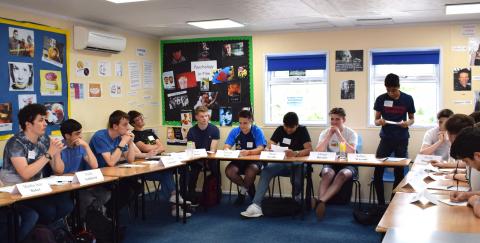A Guide to running a Simulation on the EU Freedom of Movement
UACES, in collaboration with the University of Portsmouth, ran a series of simulations in secondary schools to raise understanding about the principles of EU Freedom of Movement. This guide explains how to run a similar simulation at your own university.
 Students participating in a simulation
Students participating in a simulation
Background to the Simulation
The question addressed by this game is the free movement of EU citizens within the EU. The Mayor of Calais is threatening to close the port to all UK travellers unless the city of Dover agrees to take in some of the asylum seekers gathering in Calais. However, this prospective closure would clash with the basic principle of the free movement of EU citizens within the EU. Thus, in order to find a solution to this delicate situation, the European Commission has summoned a special roundtable discussion involving all the stakeholders.
The aim of this simulation is to encourage peer-to-peer learning and introduce European Studies to students in their last two years of secondary school (16-18-year-olds). The school students take on all the roles within the simulation and are guided through it by PhD and Masters students.
The simulation could take place within a university or a school setting depending on what is most convenient for your participants.
Essentials
- The simulation requires 25-30 school students to take on the roles
- We’d suggest that 5-7 PhD or Masters students are a good number for providing support on the day
- The simulation will take 5-6 hours to run
- It is advisable for one of the University students to take on a lead role, to introduce the simulation and to keep the day running to time
- A room that seats 60-80 people would work best on the day as this will enable students to undertake group work
Before you Begin
Two weeks before the simulation is run, it is advisable for a representative from the university to visit the school students taking part. During this session, the representative can introduce the simulation to the participants, allocate roles, explain how best to prepare for the day and distribute simulation packs.
Running the Simulation – A Suggested Timetable
10:00-10:30 – Welcome and introduction to the simulation game
10:30-11:15 – Small Group Discussion with stakeholders grouped by interest (eg politicians, citizens of Dover, citizens of Calais, refugees, business people). Students should be encouraged to come up with an A, B and C negotiating position (A – the best-case scenario for their character, B – a few compromises that their character is willing to make, C – the absolute limit of what their character is willing to concede).
11:15-11:30 – Short break
11:30-12:15 – Large Group Discussion with actors divided by country. Here negotiation strategies can be decided upon and moderators were able to get a sense of the core issues facing each nation.
12:15-13:00 – Lunch break
13:00-14:30 – The simulation is run with the aim to reach a consensus between Calais and Dover
14:30-15:00 – Debrief and discussion about the simulation and the issues it highlighted
Downloading the Pack
The full simulation pack including role cards and background reading can be downloaded here – Simulation Pack.

